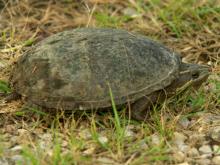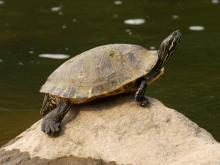Reptiles and Amphibians
Media

Species Types
Scientific Name
Sternotherus odoratus
Description
The eastern musk turtle is one of the world’s smallest turtles. It has a dark, domed upper shell and reduced lower shell. It occurs along our Mississippi River counties and in the southern two-thirds of the state.
Media

Species Types
Scientific Name
Pseudemys concinna concinna
Description
The eastern river cooter is a broad-shelled aquatic turtle with a seemingly small head. It is most abundant in the rivers and sloughs of southern Missouri but also occurs in some of our large reservoirs.
Media

Species Types
Scientific Name
Graptemys geographica
Description
The northern map turtle is a medium-sized aquatic species with a low ridge along the center of the upper shell. A small yellow spot is present behind each eye. It occurs mainly in the Ozarks and the upper Mississippi River in northeastern Missouri.
Media
Species Types
Scientific Name
Graptemys ouachitensis
Description
The Ouachita map turtle is a medium-sized aquatic species with a prominent ridge down the center of the upper shell and bright yellow lines on the head and limbs. A large yellow marking behind each eye extends, narrowing, on top of the head. It occurs in southern and eastern Missouri.
Media

Species Types
Scientific Name
Graptemys pseudogeographica pseudogeographica
Description
Missouri has two subspecies of false map turtle. The northern false map turtle occurs in the Missouri River in central and northwestern Missouri and the upper Mississippi River. The Mississippi map turtle occurs in the lower Mississippi River, southern Ozark rivers, and southwestern Missouri.
Media

Species Types
Scientific Name
Chrysemys picta bellii
Description
The western painted turtle is a small, brightly colored aquatic turtle. The upper shell is smooth and has a red-orange outer edge. The colorful lower shell has a prominent pattern of brown markings. It is found nearly everywhere in the state except the southeast region.
Media

Species Types
Scientific Name
Kinosternon subrubrum hippocrepis
Description
Although well equipped for an aquatic existence, the Mississippi mud turtle spends as much time wandering about on land as it does in water. Look for it in the Mississippi Lowlands of Missouri’s Bootheel.
Media

Species Types
Scientific Name
Acris blanchardi (formerly Acris crepitans blanchardi)
Description
Blanchard's cricket frog is a nonclimbing member of the treefrog family. It lacks the adhesive toe pads associated with treefrogs. It occurs statewide. The call is a metallic “gick, gick, gick.”
Media

Species Types
Scientific Name
Chrysemys dorsalis
Description
The southern painted turtle is small and has a prominent yellow, orange, or red lengthwise stripe down the middle of the upper shell. In Missouri, this aquatic turtle is found only in the Bootheel region.
Media

Species Types
Scientific Name
Trachemys scripta elegans
Description
The red-eared slider is an attractive aquatic turtle with yellow pinstripes and red ears. It is commonly seen basking on logs or rocks and occurs statewide, except for a few northern counties.
See Also
About Reptiles and Amphibians in Missouri
Missouri’s herptiles comprise 43 amphibians and 75 reptiles. Amphibians, including salamanders, toads, and frogs, are vertebrate animals that spend at least part of their life cycle in water. They usually have moist skin, lack scales or claws, and are ectothermal (cold-blooded), so they do not produce their own body heat the way birds and mammals do. Reptiles, including turtles, lizards, and snakes, are also vertebrates, and most are ectothermal, but unlike amphibians, reptiles have dry skin with scales, the ones with legs have claws, and they do not have to live part of their lives in water.





















